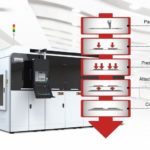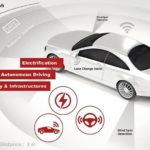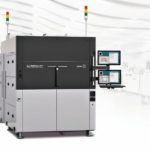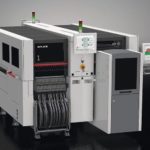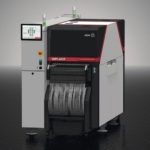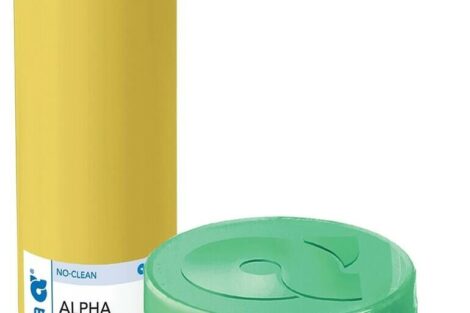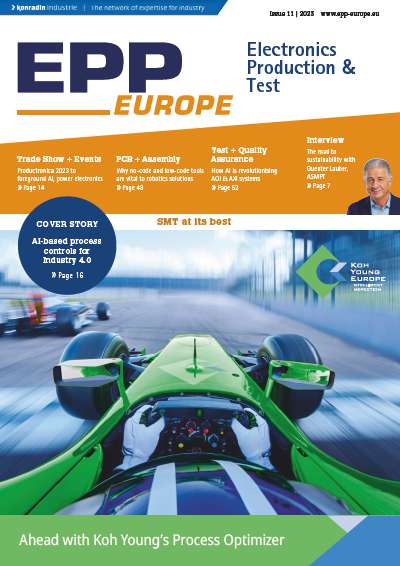As a supplier to the electronics industry, the company uses its market position and process knowledge in the areas of SMT/electronics production and backend/chip assembly to strengthen its role in the advanced packaging segment. Since automotive electronics are demanding in terms of robustness and reliability, advanced packaging technologies are driven to large extent by electrification and other automotive trends. As a result, divisions of labor and supply chains that were established over many years in the automobile industry are changing, and deliveries from OEMs and Tier 1 suppliers to OSATs (Outsourced semiconductor and test providers) are expected to increase by more than 30 percent annually. The company stands ready to meet the dramatically rising demand of OSATs and new manufacturers for advanced packaging technologies and the associated manufacturing equipment.
Solution clusters at the booth: electrification, ADAS, and connectivity
In addition to SMT solutions, the company’s 800-square-meter booth will feature innovative process solutions for advanced packaging applications in the automobile industry from a strong technology partner that can implement fully integrated process solutions with synchronized equipment. ASM has in its portfolio a multitude of solutions for a wide range of process steps, such as laser-based wafer separation, fan-out processes, bonding, SiP assembly, testing and packaging. This is all paired with in-depth process knowledge and many years of experience in the automotive sector.
Getting everything from a single source makes for lower investment costs, project times and risks. The company presents the solutions at its booth in three clusters: Electrification, ADAS (Advanced Driving Assistance Systems), and Connectivity.
Electrification
Electrically powered vehicles need more components containing power electronics. The high currents and electric outputs result in higher temperatures during switching operations and a significantly higher heat input at the contact points between electronics and substrates. The challenge for automotive electronics: due to the longer duration of high temperatures in the individual components, the different heat expansion coefficients of the surrounding materials and – last but not least – the vibrations in a moving vehicle, traditional solder joints become unreliable.
Nano-silver for more stable connections
One solution is to employ more temperature-resistant materials, such as SiC substrates and nano-silver pastes. The high melting point of silver, however, prohibits the use of a melting process to create the conductive connections, because the electrical components would not survive the high temperatures.
The solution: With silver sintering, nano-silver particles can be shaped to form stable connections without melting. The booth will feature a machine for this process, the SilverSAM (Silver Sintering Automated Machine). This highly automated solution, which can be combined with other of the company’s solutions for paste printing, die-attach and encapsulation, enables component manufacturers to produce more durable IGBT modules with improved electrical and thermal properties very efficiently.
Lots of pressure: The sintering process
For starters, the paste with nano-silver particles is applied to the DBC (direct-bond copper) or substrate with a DEK printer. This is followed by the pre-sintering process, which requires higher bonding forces as well as bonding heads for temperatures of 100 °C or more to firmly connect the die to the substrate and keep it from shifting later in the process. The basic sintering process uses pressure, heat and time in material-specific combinations to permanently join the silver particles in the paste at temperatures that are far below the silver’s melting point.
SilverSAM operates with pressures of more than 15 MPa and temperatures between 200 °C and 300 °C. The maximum sintering surface is 270 mm by 205 mm – enough for two 5-by-7-inch panels and perfect for carriers with singulated substrates. The innovative tooling in this solution can be configured to exert pressure only to the desired areas (dies, chips, etc.) while keeping cavities or grooves on the substrate untouched. A special film between the die and the tooling protects the components. After being sintered, the packages are assembled on the base plate via pick-and-place with SMT placement machines. Next, a wedge bonder like the ASM Hercules creates the strong wire connections within the modules. Finally, the components can be encapsulated with the Idealmold 3G.
Active alignment for the manufacture of CMOS image sensors
Automotive assistance systems require radar, lidar and opto-electronic sensors that must be robust, reliable and precise. One example of this technology are cameras with lenses that must be aligned perfectly over the sensor dies during their production.
One innovative solution for this process that will be unveiled at this year’s tradeshow in Munich is the company‘s Autopia. With its Active Alignment feature, it reads the image signal of the CMOS sensor and compares it with reference image values while it positions the lens. This ensures the perfect optical alignment of the entire system before it is fixed in place. This feature aligns the sensor and the lens with 11 degrees of freedom – individually, automatically and with exceptional precision for tasks like wide-angle or near-field applications.
After they have been aligned, a placement solution like the Siplace CA (Chip Assembly) can combine the sensors with SMT components to form SiPs (Systems-in-package).
Autonomous driving will generate a flood of data
Automotive advances will also place new demands on electronics outside of the vehicle. Autonomous driving requires Car2X communication, i.e. the vehicles must communicate with other vehicles and services. The basis for this is the 5G mobile data network that is currently under construction, and the vehicles themselves must have powerful and highly miniaturized communication modules installed.
This degree of integration is achieved by combining many heterogeneous active and passive components into a SiP (System-in-a-Package) with technologies like active embedding or multi-layered, three-dimensional structures. For these processes, the company offers in addition to high precision solutions like the Nucleus and the Siplace CA – machines that combine the precision of chip assembly with the speed of SMT technology. Without these productivity leaps, neither the required quantities nor the cost targets of the automotive industry could be realized.
But the communication needs go beyond the vehicle itself. To ensure speedy data communication, transmission stations along the roads and a dense network of decentralized data centers are required. These data centers are linked to each other as well as to larger data centers. The required data rates of 100 to 600 Gbps between the data centers and between servers can only be achieved by building photonic networks and a new generation of opto-electronic transceivers for fiberoptic networks.
Building these transceivers requires the placement of optical components with a precision of below 1 µm. Designed especially for the efficient production of these high-precision transceivers, the company offers the Amicra Nano. Instead of building and aligning transceivers from many components for the conversion of electrical signals into light (and back again), it creates PICs (Photonic Integrated Circuits) with a lithographic process. This requires far fewer components, reduces the complexity of the alignment process, and increases the yield.
Growth opportunities for electronics manufacturers
The extensive ASM portfolio with its advanced packaging solution clusters reflects the growth opportunities being offered by the automotive sector for OSATs and electronics manufacturers.
productronica, Booth A3-377
Info
At the 2019 productronica, the company will dedicate a special area of its booth to advanced packaging in the automobile industry. In three clusters – Electrification, ADAS and Connectivity – they will feature integrated process solutions and its latest innovations in the field.
David Felicetti,
Product Marketing Manager, ASM Back End Systems.
Zusammenfassung
Die Automobilindustrie treibt die Nachfrage nach Advanced-Packaging an. Insofern widmet ein Technologie-Lieferant einen großen Teil seines Messestandes auf der diesjährigen productronica diesem Thema.
Résumé
L‘industrie automobile stimule la demande d‘emballages à la pointe de la technologie. A cet égard, un fournisseur de technologie consacre une grande partie de son stand au salon productronica de cette année à ce thème.
Резюме
Автомобильная промышленность стимулирует спрос на современную компоновку. В связи с этим один из поставщиков технологий посвящает данной теме в этом году значительную часть своего стенда на выставке productronica.


